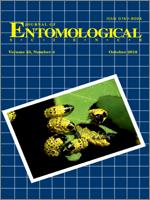The sublethal effects of buprofezin, abamectin, and a plant-derived extract from aerial portions of Echinophora platyloba DC (Umbelliferae) on the mortality, developmental time, adult longevity, and fecundity of the parasitoid Encarsia formosa Gahan were studied. Laboratory bioassays determined that the median lethal concentrations (LC50) of abamectin, buprofezin, and the Echinophora platyloba extract were 724.2, 1,202.9, and 894.4 mg/l for larvae, 971.4, 1,380.2, and 1,287.0 mg/l for pupae, and 306.2, 3,309.1, and 831.7 mg/l for adults, respectively. Preadult development time was reduced following exposure to sublethal concentrations (LC30) of all insecticides (P < 0.01). Treatment of larvae and pupae with buprofezin or abamectin significantly decreased adult longevity (P < 0.01); however, the E. platyloba extract reduced adult longevity only when exposed during the pupal stage. Adult fecundity was not affected when larvae or pupae were treated with any of the insecticides (P > 0.05). However, decreased fecundity was observed when adult wasps were exposed to abamectin and, to a lesser extent, the E. platyloba extract (P < 0.01). In comparison to abamectin, sublethal concentrations of the E. platyloba extract and buprofezin are less harmful to the survival, longevity, and fecundity of Encarsia formosa and should be further developed for use in integrated pest management of the greenhouse whitefly, Trialeurodes vaporariorum Westwood, in greenhouse production systems.
How to translate text using browser tools
1 October 2018
Toxicity and Sublethal Effects of Selected Insecticides on Life Parameters of Encarsia formosa (Hymenoptera: Aphelinidae), a Parasitoid of Trialeurodes vaporariorum (Hemiptera: Aleyrodidae)
Fatemeh Rashidi,
Gadir Nouri Ganbalani
ACCESS THE FULL ARTICLE
bioassay
fecundity
greenhouse whitefly
longevity
sublethal effects





